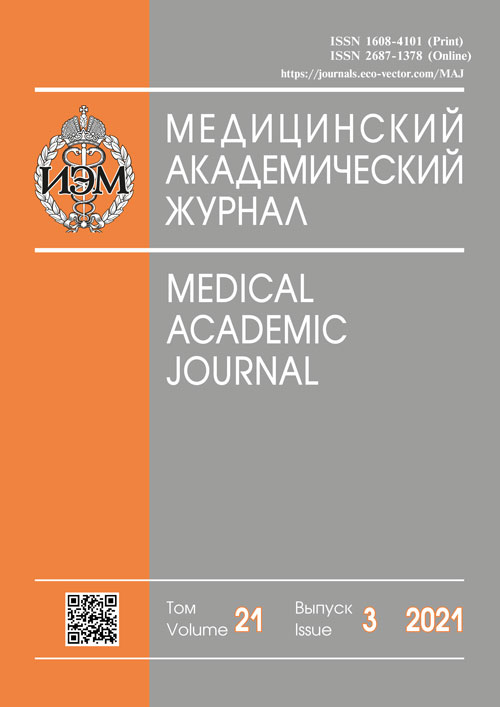Estimation of 100 nm particle distribution kinetics in mouse lung using confocal laser scanning microscopy
- Authors: Vavilova J.D.1, Bolkhovitina E.L.1, Bogorodskiy A.O.2, Okhrimenko I.S.2, Borshchevskiy V.I.2, Shevchenko M.A.1
-
Affiliations:
- Shemyakin and Ovchinnikov Institute of Bioorganic Chemistry Russian Academy of Sciences
- Moscow Institute of Physics and Technology (National Research University)
- Issue: Vol 21, No 3 (2021)
- Pages: 103-108
- Section: Conference proceedings
- URL: https://bakhtiniada.ru/MAJ/article/view/79200
- DOI: https://doi.org/10.17816/MAJ79200
- ID: 79200
Cite item
Abstract
BACKGROUND: Daily, people inhale airborne viral particles, some of which have a size of about 100 nm, such as particles of SARS-CoV-2. Kinetics of such 100 nm particle distribution in the respiratory tract is important, however, not a properly investigated question.
AIM: To estimate the dissemination of inert viral particles based on the analysis of the spatial distribution of fluorescent 100 nm particles in the mouse lungs at different time points after the application.
MATHERIALS AND METHODS: Fluorescent particles of 100 nm size were applied to C57BL/6 mice. 6, 24, 48 and 72 hours after, lungs were excised and fixed. Lung lobes were stained with immunohistochemistry as whole-mounts and then underwent optical clearance. Three-dimensional images of whole-mount mouse lung lobes were acquired using confocal laser scanning microscopy.
RESULTS: 6 hours after the particle application particles were detected in lungs both as single particles and as particle agglomerates. Particles were both free and internalized by phagocytic cells. 24 hours after the application particles were detected both in bronchial lumen and in the alveolar space. Particles were detected in the mouse lungs up to 72 hours after the application.
CONCLUSIONS: Reaching the respiratory tract of mammalian, inert particles which size equal to SARS-CoV-2 particle size distribute both in bronchi and in alveoli and undergoes internalization of phagocytic cells.
Full Text
##article.viewOnOriginalSite##About the authors
Julia D. Vavilova
Shemyakin and Ovchinnikov Institute of Bioorganic Chemistry Russian Academy of Sciences
Email: Juliateterina12@gmail.com
ORCID iD: 0000-0002-9075-218X
Postgraduate student, junior scientific researcher
Russian Federation, MoscowElena L. Bolkhovitina
Shemyakin and Ovchinnikov Institute of Bioorganic Chemistry Russian Academy of Sciences
Email: alenkash83@gmail.com
ORCID iD: 0000-0002-3386-509X
junior scientific researcher
Russian Federation, MoscowAndrey O. Bogorodskiy
Moscow Institute of Physics and Technology (National Research University)
Email: bogorodskiy173@gmail.com
ORCID iD: 0000-0002-7589-7823
junior scientific researcher
Russian Federation, DolgoprudnyIvan S. Okhrimenko
Moscow Institute of Physics and Technology (National Research University)
Email: ivan.okhrimenko@phystech.edu
ORCID iD: 0000-0002-1053-2778
SPIN-code: 8418-0194
scientific researcher
Russian Federation, DolgoprudnyValentin I. Borshchevskiy
Moscow Institute of Physics and Technology (National Research University)
Email: borshchevskiy.vi@phystech.edu
ORCID iD: 0000-0003-4398-9712
SPIN-code: 2018-8957
senior scientific researcher
Russian Federation, DolgoprudnyMarina A. Shevchenko
Shemyakin and Ovchinnikov Institute of Bioorganic Chemistry Russian Academy of Sciences
Author for correspondence.
Email: mshevch@gmail.com
ORCID iD: 0000-0001-5278-9937
SPIN-code: 8509-1096
scientific researcher
Russian Federation, MoscowReferences
- Rao G.V., Tinkle S., Weissman D.N. et al. Efficacy of a technique for exposing the mouse lung to particles aspirated from the pharynx // J. Toxicol. Environ. Health A. 2003. Vol. 66, No. 15. P. 1441–1452. doi: 10.1080/15287390306417
- Scott G.D., Blum E.D., Fryer A.D., Jacoby D.B. Tissue optical clearing, three-dimensional imaging, and computer morphometry in whole mouse lungs and human airways // Am. J. Respir. Cell. Mol. Biol. 2014. Vol. 1, No. 51. P. 43–55. doi: 10.1165/rcmb.2013-0284OC
- Li W., Germain R.N., Gerner M.Y. High-dimensional cell-level analysis of tissues with Ce3D multiplex volume imaging // Nat. Protoc. 2019. Vol. 14, No. 6. P. 1708–1733. doi: 10.1038/s41596-019-0156-4
- References
- Rao GV, Tinkle S, Weissman DN, et al. Efficacy of a technique for exposing the mouse lung to particles aspirated from the pharynx. J Toxicol Environ Health A. 2003;66(15):1441–1452. doi: 10.1080/15287390306417
- Scott GD, Blum ED, Fryer AD, Jacoby DB. Tissue optical clearing, three-dimensional imaging, and computer morphometry in whole mouse lungs and human airways. Am J Respir Cell Mol Biol. 2014;1(51):43–55. doi: 10.1165/rcmb.2013-0284OC
- Li W, Germain RN, Gerner MY. High-dimensional cell-level analysis of tissues with Ce3D multiplex volume imaging. Nat Protoc. 2019;14(6):1708–1733. doi: 10.1038/s41596-019-0156-4
Supplementary files









